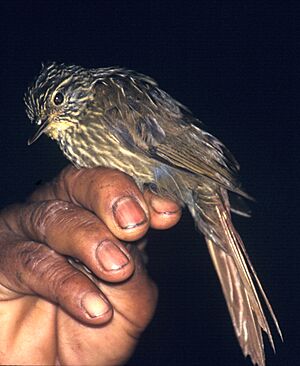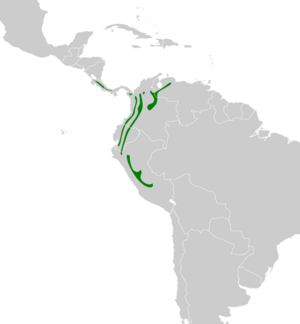Lineated foliage-gleaner facts for kids
Quick facts for kids Lineated foliage-gleaner |
|
|---|---|
 |
|
| Conservation status | |
| Scientific classification | |
| Genus: |
Syndactyla
|
| Species: |
subalaris
|
 |
|
The lineated foliage-gleaner (Syndactyla subalaris) is a small, active bird that lives in the forests of Central and South America. It belongs to the ovenbird family, which is known for building unique nests. This bird is found in several countries, including Colombia, Costa Rica, Ecuador, Panama, Peru, and Venezuela.
Contents
About Its Name and Family
Birds are often grouped into families and subspecies. Subspecies are like different versions of the same animal, often with small differences in looks or where they live. Scientists sometimes disagree on how many subspecies a bird has.
Most bird experts agree that the lineated foliage-gleaner has six subspecies:
- S. s. lineata
- S. s. tacarcunae
- S. s. subalaris
- S. s. striolata
- S. s. olivacea
- S. s. mentalis
What It Looks Like
The lineated foliage-gleaner is about 17 to 19 centimeters (6.7 to 7.5 inches) long. It weighs between 26 and 40 grams (0.9 to 1.4 ounces). Both male and female birds look very similar.
Adult birds have a light, broken stripe above their eyes, called a supercilium. Their face is dark brown with small buff (pale yellowish-brown) spots. The top of their head is dark brown with thin buff streaks. Their back is a rich dark brown with long, thin buff streaks. Their tail is dark chestnut, and their wings are rich dark brown.
Their throat is buff with blurry brownish streaks. Their chest is dark brown with buff streaks. The belly and sides are a lighter brown with thinner streaks. Their eyes are brown, and their beak is dark brown on top and lighter underneath. Their legs and feet are olive-green or greenish-gray.
Younger birds are usually brighter than adults. They have a blacker crown with cinnamon streaks and a more reddish-brown back.
Different subspecies have slight variations in color. For example, some might have a paler back, a more yellowish throat, or grayer underparts.
Where It Lives and Its Home
The lineated foliage-gleaner lives in different mountain areas, not all connected. This is called a disjunct distribution.
Each subspecies lives in specific regions:
- S. s. lineata: In the mountains of Costa Rica and western Panama.
- S. s. tacarcunae: In the Serranía del Darién mountains, from eastern Panama into northwestern Colombia.
- S. s. subalaris: In the Western and Central Andes of Colombia, and south through western Ecuador.
- S. s. striolata: In the Eastern Andes of Colombia and the Andes of western Venezuela.
- S. s. olivacea: In southwestern Táchira state in western Venezuela.
- S. s. mentalis: From eastern Ecuador south into Peru.
These birds live in evergreen forests. These are forests where trees stay green all year. They prefer areas along streams with thick plants close to the ground. They usually live at elevations between 1,000 and 2,300 meters (3,300 to 7,500 feet) high in the mountains. Sometimes they can be found as low as 600 meters (2,000 feet) or as high as 2,800 meters (9,200 feet) in Colombia.
Bird Behavior
Movement
The lineated foliage-gleaner stays in the same area all year round. It does not migrate.
Feeding Habits
This bird mainly eats arthropods, which include insects and spiders. Sometimes, it might also eat small animals like frogs or lizards. It usually looks for food alone or in pairs. It often joins mixed-species feeding flocks, which are groups of different bird species feeding together.
It mostly searches for food from the forest floor up to the middle levels of the trees. It picks and probes for its prey among leaves, moss, and plants that grow on other plants (called epiphytes). It often climbs along large branches and vines. Sometimes, it even hangs upside down to reach food under branches!
Reproduction
Not much is known about when or how the lineated foliage-gleaner nests. Scientists believe they are monogamous, meaning a male and female bird stay together to raise their young.
Only one nest has been fully described. It was a cup-shaped nest made of soft fibers. It was built inside a hole in a tree and held two eggs. More research is needed to learn about their breeding habits.
Bird Sounds
The lineated foliage-gleaner's song is a fast, scratchy sound. It has 6 to 10 notes that speed up. It can sound like "bzert, bzert, jzut, jzut-jj-jj-jj" or "anh, anh, anh-anh-anh-anhanhanhanh." Its call is a dry, harsh sound, like "tzuk," "tcheck," or "jert."
Its Conservation Status
The IUCN (International Union for Conservation of Nature) has listed the lineated foliage-gleaner as a species of "Least Concern." This means it is not currently in danger of disappearing. It lives across a very large area. Scientists estimate there are at least 500,000 adult birds, though this number is thought to be slowly decreasing.
No major threats have been found for this bird. It is considered common in many parts of its range and lives in several protected areas.


